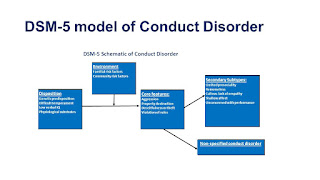Conduct Disorder
Conduct Disorder is a serious behavioral and emotional disorder that can occur in children and teens. A child with this disorder may display a pattern of disruptive and violent behavior and have problems following rules. A repetitive and persistent pattern of behavior is observed in which the basic rights of others or major age-appropriate societal norms or rules are violated.
Features
1. a repetitive and persistent pattern of behavior in which the basic rights of others or major age-appropriate societal norms or rules are violated
2. The disturbance in behavior causes clinically significant impairment in social, academic, or occupational functioning
3. The behavior pattern is usually present in a variety of settings, such as home, at school, or in the community. Because individuals with conduct disorder are likely to minimize their conduct problems, the clinician often must rely on additional informants.
Symptoms
Symptoms of conduct disorder vary depending on the age of the child and whether the disorder is mild, moderate, or severe. In general, symptoms of conduct disorder fall into four general categories:- Aggressive behavior: These are behaviors that threaten or cause physical harm and may include fighting, bullying, being cruel to others or animals, using weapons, and forcing another into sexual activity.
- Destructive behavior: This involves intentional destruction of property such as arson (deliberate fire-setting) and vandalism (harming another person's property).
- Deceitful behavior: This may include repeated lying, shoplifting, or breaking into homes or cars in order to steal.
- Violation of rules: This involves going against accepted rules of society or engaging in behavior that is not appropriate for the person's age. These behaviors may include running away, skipping school, playing pranks, or being sexually active at a very young age.
Diagnosis
1. Individuals with conduct disorder often initiate aggressive behavior and react aggressively to others. They may display bullying, threatening, or intimidating behavior
2. initiate frequent physical fights; use a weapon that can cause serious physical harm; be physically cruel to people or animals; steal while confronting a victim (e.g., mugging, purse snatching, extortion, armed robbery); or force someone into sexual activity
3. Deliberate destruction of others' property may include deliberate fire setting with the intention of causing serious damage or deliberate destroying of other people's property in other ways
4. Acts of deceitfulness or theft may include breaking into someone else's house, building, or car; frequently lying or breaking promises to obtain goods or favors or to avoid debts or obligations or stealing items of nontrivial value without confronting the victim
Treatment
Treatment for conduct disorder is based on many factors, including the child's age, the severity of symptoms, as well as the child's ability to participate in and tolerate specific therapies. Treatment usually consists of a combination of the following:- Psychotherapy (a type of counseling) is aimed at helping the child learn to express and control anger in more appropriate ways. A type of therapy called cognitive-behavioral therapy aims to reshape the child's thinking (cognition) to improve problem solving skills, anger management, moral reasoning skills, and impulse control. Family therapy may be used to help improve family interactions and communication among family members. A specialized therapy technique called parent management training (PMT) teaches parents ways to positively alter their child's behavior in the home.
- Although there is no medication formally approved to treat conduct disorder, various drugs may be used to treat some of its distressing symptoms, as well as any other mental illnesses that may be present, such as ADHD or major depression.



No comments:
Post a Comment